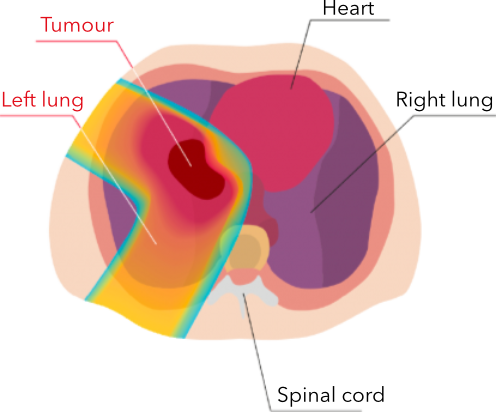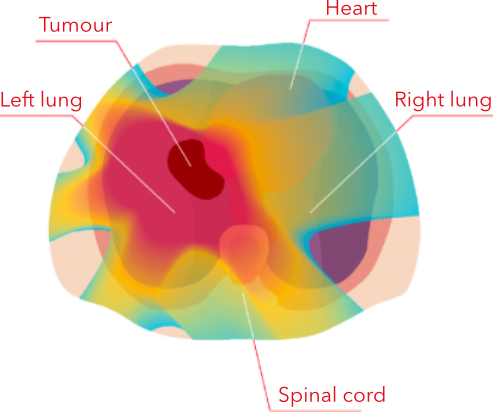NSCLC therapy depends on the extent of the disease, the general condition of the patient and further diseases.
Indications for Proton Radiotherapy
- St. I, IIA – T1-2N0M0, inoperable due to comorbidities or due to refusing of operation
- St IIB, IIIA – locally advanced tumours (T1-4 N1), non-resectable
- St IIIB – T1-4, N2 – locally advanced tumours (T1-4 N1), non-resectable
Contraindications
- Stage N3, T4 (multiple tumours)
- One or more severe comorbidities (each situation is evaluated individually)
- Metal/ceramic parts in the radiation field
- Presence of a pacemaker
Advantages of Proton Therapy
In early carcinoma treated with SBRT, proton therapy enables us to irradiate the target volume with fewer fields (in comparison with photon IMRT), and decrease the integral dose. Decreasing the integral dose is associated with a lower risk of stochastic effects, i.e. lower risk of development of radiation pneumonitis, oesophagitis and secondary tumours. Furthermore, the dose to critical tissues decreases, primarily to pulmonary tissue.
In locally advanced lung carcinoma, proton therapy is better than photon therapy. It enables us to accelerate (shorten the total irradiation time), use a lower number of treatment fractions (hypofractionation), decrease the total dose while maintaining or decreasing the toxicity (lower load of critical organs in the same dose in comparison with the phototherapy), thus providing a higher quality of life for the patients. A further advantage is the lower integral dose when compared with photon irradiation, similarly to the early carcinoma.
PROTON IRRADIATION
PHOTON IRRADIATION

Protons target the tumour directly, sparing healthy tissues and organs from unwanted effects.

Photons irradiate the tumour as well as the healthy tissues and organs around it.
By reducing radiation exposure to surrounding healthy tissues, the dose of radiation to the tumour can be increased when using proton beam radiation, increasing the chance of a cure.
Results with Proton Therapy
It has been demonstrated in patients with non small cell lung cancer (NSCLC) that dose escalation improves local control and survival. Thanks to the physical properties of protons (Bragg peak), minimisation of the output dose occurs, leading to the sparing of critically important tissues such as the heart, esophagus, airways, major vessels, and the spinal cord in comparison with photon radiation therapy.
The reduction of toxicity in proton radiotherapy (PRT) leads to a reduced cost in the treatment of side effects, thereby reducing the cost of patient hospitalisation. Dose optimisation also makes it possible to spare healthy tissue in patients with complicated anatomical situations.
Patients whose tumour position changes due to respiratory movements are irradiated using a controlled breathing method called Deep Inspiration Breath Hold (DIBH). Click here to learn how this breathing method works.
To learn more about proton therapy for lung cancer, or to find out if you are a suitable candidate for treatment at our centre, contact us today. Our team will get back to you with a detailed response as soon as possible.
* Suitability for treatment at our centre must be determined by our medical team.
